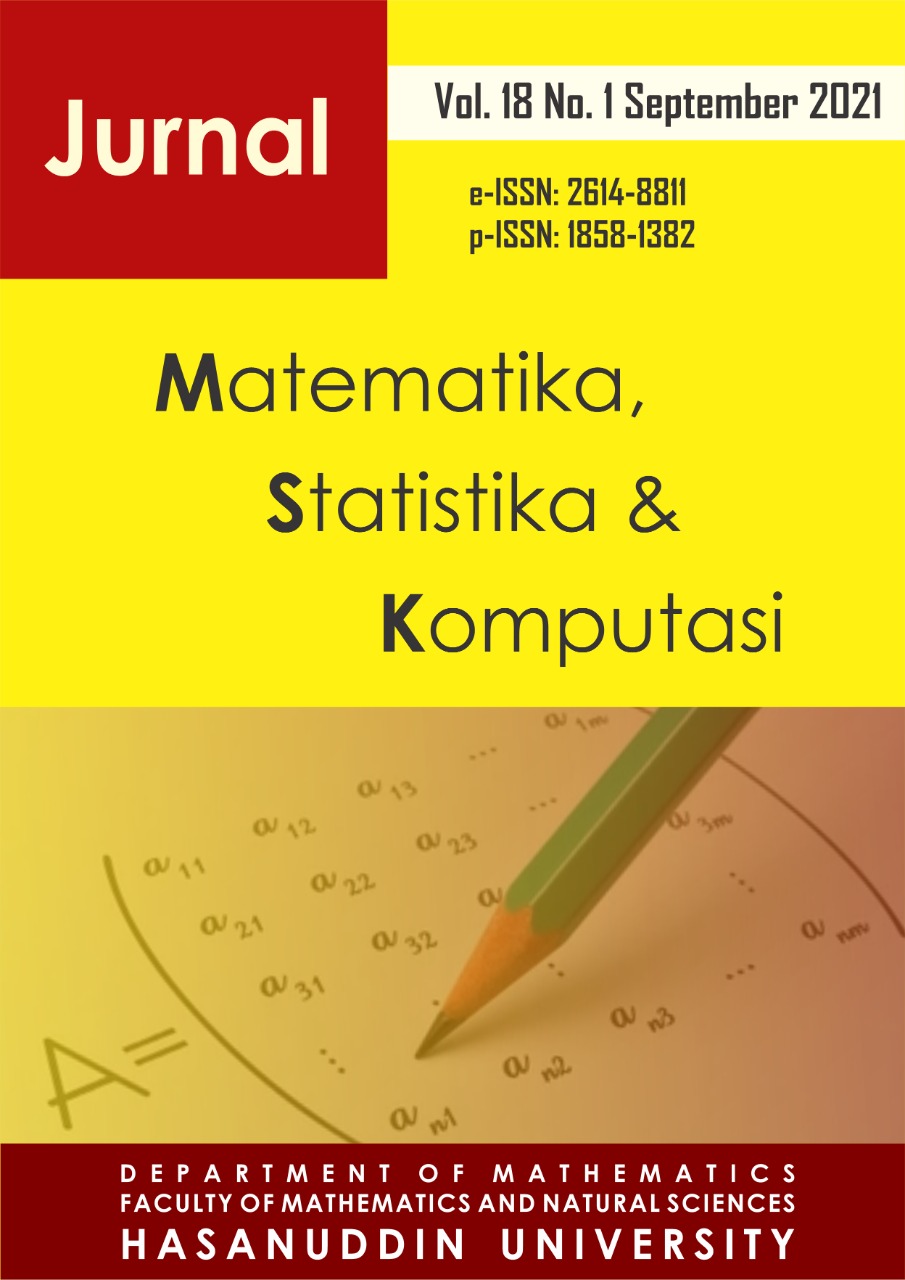Optimal Control of a Mathematical Model of Smoking with Temporary Quitters and Permanent Quitters
DOI:
https://doi.org/10.20956/j.v18i1.13974Keywords:
Mathematical Model on Smoking, ontryagin Minimum Principle, Forward-Backward Sweep Method, Optimal Control.Abstract
Abstract
This article discusses the optimal control of a mathematical model on smoking. This model consists of six population classes, namely potential to become smoker snuffing class irregular smokers regular smokers temporary quitters and permanent quitters The completion of this research uses the Pontryagin minimum principle and numerically using the forward-backward Sweep method. Numerical simulations of the optimal problem show that with the implementation of education campaigns and anti-nicotine medicine, the smokers can be decreased more quickly and the smoking population who quit permanently can be increased. The implementation of both through large amounts needs to be done from the beginning. The use of control in the form of education campaigns is of great value until the end of the research period means that it needs to be done continuously to reduce the number of smokers in the population.
References
Agustianingsih S., Reorita R. & Renny., 2020. Kontrol Optimal pada Model SIR dengan Pengaruh Vaksinasi, Karantina, dan Faktor Imigrasi. Jurnal Matematika, Statistika & Komputasi. Vol. 16, No. 3, 311-324.
Alkhudhari Z., Al-Sheikh S. & Al-Tuwairqi S., 2014. Global Dynamics of a Mathematical Model on Smoking. ISRN Applied Mathematics, Vol. 2014, 1-8.
Alkhudhari Z., Al-Sheikh S. & Al-Tuwairqi S., 2014. The Effect of Occasional Smokers on The Dynamics of a Smoking Model. International Mathematical Forum, Vol. 9, No. 25, 1207-1222.
Alkhudhari Z., Al-Sheikh S. & Al-Tuwairqi S., 2015. The Effect of Heavy Smokers on The Dynamics of a Smoking Model. International Journal of Differential Equations and Applications, Vol. 14, No. 4, 343-356.
Alzahrani E. & Zeb A., 2020. Stability Analysis and Prevention Strategies of Tobacco Smoking Model. Springer Open Journal, Vol. 2020, No. 3, 1-13.
Anggriani N., Toaha S. & Kasbawati., 2021. Kontrol Optimal Model Matematika terhadap Dinamika Penyebaran Penyalahgunaan Narkoba. Jurnal Matematika, Statistika & Komputasi. Vol. 17, No. 3, 339-348.
Cahyono E., 2013. Pemodelan Matematika, Edisi Pertama. Graham Ilmu., Yogyakarta.
Din Q., Ozair M., Hussain T. & Saeed U., 2016. Qualitative Behavior of Smoking Model. Advance in Difference Equations, Vol. 2016(2016), No. 96, 1-12.
Garsow, C.C., Salivia, G.J. & Herrera, A.A., 1997. Mathematical Models for The Dynamics of Tobacco Use, Recovery and Relapse. Technical Report Series BU-1505-M.
Guerrero F., Santonja, F.J. & Villanueva, R.J., 2011. Analysing The Spanish Smoke-Free Legislation of 2006: A New Method to Quantify Its Impact Using a Dynamic Model. International Journal of Drug Policy, Vol. 22, 247–251.
Kemenkes RI., 2018. Hasil Utama RISKESDAS 2018. Badan Penelitian dan Pengembangan Kesehatan Kementerian Kesehatan RI., Jakarta.
Lenhart S. & Workman J., 2007. Optimal Control Applied to Biological Models. Chapman & Hall., New York.
Matintu, S.A. 2017. Smoking as Epidemic: Modeling and Simulation Study. American Journal of Applied Mathematics, Vol. 5, No. 1, 31-38.
Pang L., Zhao Z., Liu S. & Zhang X., 2015. A Mathematical Model Approach for Tobacco Control in China. Applied Mathematics and Computation, Vol. 259, 497-509.
Pang L., Liu S., Zhang X & Tian T., 2019. The Cost-Effectiveness Analysis and Optimal Strategy of the Tobacco Control. Computational and Mathematical Methods in Medicine. Vol. 2019, 1-15.
Salawati T & Indrawati, N. D., 2016. Analisis Kebutuhan untuk Merancang Komik Anak “Asetaro” (Aku Akan Tetap Sehat Tanpa Rokok). Jurnal Kesehatan Masyarakat, Vol. 11, No. 2, 96-105.
Sharomi O & Gumel, A.B., 2008. Curtaling Smoking Dynamics: A Mathematical Modeling Approach. Applied Mathematics and Computation, Vol. 195, 475–499.
Sikander W., Khan U., Ahmed N. & Mohyud-Din, S.T., 2017. Optimal Solutions for a Bio Mathematical Model for The Evolution of Smoking Habit. Result in Physic, Vol. 7, 510-517.
Verma V., 2020. Optimal Control Analysis of a Mathematical Model on Smoking. Modelling Earth Systems and Environment. doi.org/10.1007/s40808-020-00847-1.
WHO (World Health Organization). 2019. WHO Launches New Report On Global Tobacco Use Trends. Publishing, Switzerland. https://www.who.int/news/item/19-12-2019-who-launches-new-report-on-global-tobacco-use-trends. [26 November 2020].
Zaman G., 2011. Qualitative Behavior of Giving Up Smoking Models. Bull.Malays.MathSci.Soc, Vol. 34, No. 2, 403-415.
Zaman G., 2011. Optimal Campaign in The Smoking Dynamics. Computational and Mathematical Methods in Medicine, 1-9.
Zeb A., Zaman G. & Momani S., 2013. Square-root Dynamics of a Giving Up Smoking Model. Applied Mathematical Modelling, Vol. 37, 5326-5334.
Downloads
Published
Issue
Section
License
Copyright (c) 2021 Author and publisher

This work is licensed under a Creative Commons Attribution 4.0 International License.

This work is licensed under a Creative Commons Attribution 4.0 International License.
Jurnal Matematika, Statistika dan Komputasi is an Open Access journal, all articles are distributed under the terms of the Creative Commons Attribution License, allowing third parties to copy and redistribute the material in any medium or format, transform, and build upon the material, provided the original work is properly cited and states its license. This license allows authors and readers to use all articles, data sets, graphics and appendices in data mining applications, search engines, web sites, blogs and other platforms by providing appropriate reference.







